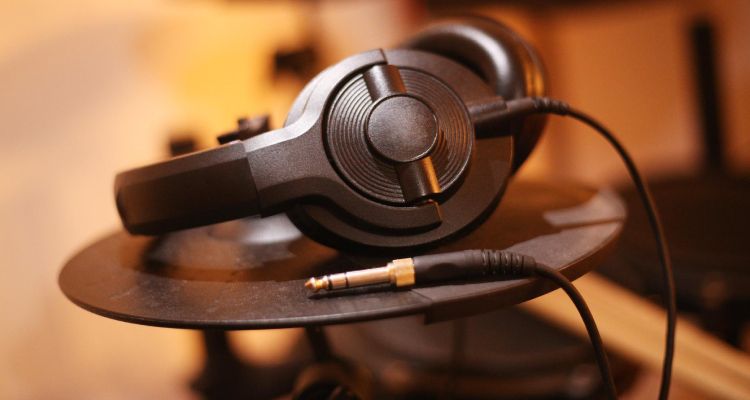Drums are undeniably one of the most fun and rewarding instruments you can learn to play, but a drum set is also significantly louder than most other instruments. This can make it difficult to practice without disturbing others.
The loudness of drums depends on the drummer’s playing style, the drum set’s specific setup, and the velocity with which they are played. It’s important to know how loud drums are in order to protect your ears from potential damage.
Whether you’re an experienced drummer or you’re considering learning to drum, understanding the loudness will help you in all aspects of your playing. In this guide, discuss how loud a drum set is in detail.
Contents
How Loud are Drums?
On average, a drum set produced volumes of between 90-130dB. The individual drums can produce a wide range of volumes, which is affected by their size, along with the drummer’s playing style and skill level. The high volume of a drum set makes wearing hearing protection very important.
Drums are an awesome instrument to play. They’re an essential part of a band or ensemble across the most popular genres. A drum set’s versatility, power, and loudness make it integral to live and recorded music.
In addition to keeping the rhythm and pulse of a song, the drums also significantly impact the overall volume. The other instrument often follows when they get louder, creating a bigger sound.
However, while the loudness of drums is one of the instrument’s main strengths, it can also be a drawback. Unlike other acoustic instruments, such as acoustic guitars or pianos, drums are challenging to play without disturbing people unless a room is sufficiently soundproofed.
How Many Decibels is a Drum Set?
The loudness of a drum set is measured in decibels (dB.) The dB varies depending on factors such as the type of drums played, their size and materials, and the velocity with which the drummer hits them.
On average, an acoustic drum kit is likely to reach around 100 dB. This level is usually reached when a drummer is playing hard but not using all of their power to hit the drums.
An experienced drummer in a heavy rock or metal band could easily cause their drum set to produce up to 130 dB. A jazz drummer, playing a soft and intricate style, may reach a lower volume of 90 dB.
To put these dB levels into perspective, we need to compare them to other common sound volumes.
- 30dB – Person whispering
- 60dB – Conversation between two people
- 85dB – Traffic on a busy street
- 100dB – Nearby car horn
- 120dB – In the crowd at a rock concert
- 135 dB – Jet plane engine at takeoff
As you can see, a drum set has the potential to be played at around the same level as busy street traffic, but when played loudly, it can reach a similar dB level as a jet engine taking off!
The Loudness of Individual Drums

Unlike other acoustic instruments, a drum set is made up of several individual instruments. Therefore, the loudness is caused by the combination of the various drums being played simultaneously.
Now that we’ve established the overall loudness of a drum set, we need to analyze the volume of the individual drums to understand where most of the volume is coming from.
Kick Drum
The kick drum, or “bass drum,” is the largest drum in a set. Rather than being played with a stick, this drum is played with a kick pedal that, when pressed, causes a beater to strike the skin, producing a low-pitched sound.
When played individually at a relatively high velocity, a bass drum produced a volume of between 95 dB to 105 dB. This proves that the size of the drum doesn’t necessarily mean it is the loudest!
Snare Drum
Snare drums produce a distinctive, crisp sound heard commonly in popular music.. They can be played alone in marching bands, drum solos, or other drums as part of a groove. The snare is commonly 14” in diameter.
Despite being a relatively small drum, snare drums have a volume of between 90 dB – 125 dB. They have one of the widest dynamic ranges of any drum, and the volume varies depending on how hard and where the skin is struck.
It’s possible to play the snare drum very quietly, as jazz drummers often demonstrate when soloing. Using rim clicks and different ways of striking the snare affects its volume considerably.
Toms
A standard drum set includes three toms. Two of these toms are known as “rack toms,” as they are usually mounted to the bass drum. The other is a “floor tom,” which is positioned on the opposite side of the snare in a conventional setup.
Toms produce varying tones. The floor tom is the loudest of the three, reaching around 110dB. The smallest rack tom can reach 100dB, and the medium-sized tom has a maximum volume of around 105 dB.
Cymbals
Cymbals are generally the loudest part of a drum kit. The three most common varieties of cymbals are the hi-hats, ride, and crash.
Hi-hats can be opened and closed using a foot pedal. When they’re closed, they can reach around 95dB, but when opened, this increases to around 105 dB.
A crash cymbal is used to accent certain beats, and it can reach high volumes of around 125dB when played at full velocity. A ride cymbal with a resonant tone can also reach around 125dB when played hard.
Drummers often dampen their cymbals to avoid them being too loud for the other drums in the set.
How Loud Are Electronic Drums?

Electronic drums allow you to play at much lower volumes than acoustic drums because they use sensitive pads to generate a sound. When the pad is struck, this triggers a digital sample to be played.
Technically, an electronic drum set can be played at similar volumes to an acoustic drum set if you connect it to a powerful pair of speakers and turn the level high. The maximum volume would depend on the capabilities of the speakers.
Most drummers use headphones when practicing with electronic drum sets, as this allows them to play at a significantly lower volume. The only sound that can be heard when using headphones are the sticks and the kick pedal hitting the pads/
When played through headphones, you can expect the sound of the electronic drum set to reach a high of around 70 dB. This is considerably quieter than an acoustic drum set played at full volume.
When an amplifier and speaker are used with the electric drums, volumes of between 100 dB and 120 dB are common.
One of the main advantages of using an electronic drum kit is that, to an extent, it puts you in control of the volume of the instrument. You can simply reduce the level if you feel that the sound is too loud in your headphones.
The reduction of the level means that you don’t necessarily need to play softer, as you would if you were trying to reduce the volume of an acoustic drum set.
Protecting Your Hearing

As we’ve discussed in this guide, drums can be an exceedingly loud instrument. It’s, therefore, vital that you take certain measures to protect your hearing when drumming in order to ensure you don’t damage your ears.
Thankfully, musicians can easily get their hands on an excellent set of earplugs that will significantly reduce the volume of the sounds when drumming. Earplugs are small, easy to put in, and highly effective.
They work by creating a physical barrier between your inner ear and the sound waves from the drum kit. Depending on the design of the earplugs, they may target specific frequency bands, such as the higher frequencies of the cymbals, which are particularly dangerous to the ears.
Another effective way to protect your hearing is to get some molded in-ear monitors made to use when performing live. These devices can replace stage monitors, allowing you to hear all of the instruments clearly while also protecting your ears from loud noises.
It’s also important to take regular breaks when playing drums. Even with hearing protection, the risk of damage increases significantly when you play for longer periods of time. Having a break allows your ears to rest and recover.
There are other ways you can reduce a drum set’s volume, which I’ve written about in this guide here. Getting a good electronic drum kit to practice on is also a great way to avoid repetitively risking damage to your ears.
Although they’re not exactly the same as acoustic drum sets, electronic kits have come a long way in recent years, and there are some excellent options available for drummers.
Summary
Now that you’re aware of how loud drums can be, you can use this information to your advantage. Protecting your ears when drumming is absolutely essential because once damage occurs, it’s rare that it can be improved.









